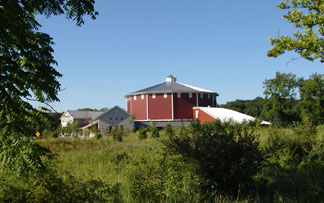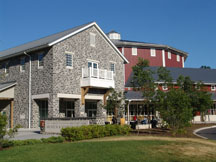
GETTYSBURG, Pa. — Housing one of the largest collections of Civil War memorabilia in the world, the recently completed $103 million Gettysburg National Military Park Museum and Visitor Center also contains modern-day green features ranging from a geothermal heating and cooling system to efficient water fixtures.
An abundance of modern-day energy-saving features were enough to get the two-year old museum and visitor center a LEED Gold certification for its sustainable systems and building design.
Operated by the Gettysburg Foundation and the National Park Service, the 139,000-square-foot center is often a visitor’s first stop in the national park, housing a 20,000-square-foot interpretive gallery, two 180-seat theaters, a cafeteria, dining areas, a gift and shop, collection storage area, and official offices.
A variety of elements contributed to the facility attaining LEED certification. First, Architects from LSC Design Inc. designed a 207-well geothermal heating and cooling system for the visitor center. The building’s reflective roof diminishes heat-island effect, while flow toilets and sinks decrease water usage throughout. Underground storage tanks collect storm water, which reduces site run-off.
Insulated metal wall panels — the kind that are typically used in cold storage warehouses — optimize energy performance and help maintain the constant temperature and humidity controls required to preserve the Gettysburg Cyclorama, a circular re-creation of the original Battle of Gettysburg oil-on-oil painting. The artistic work, which depicts the Battle of Gettysburg on July 3, 1863, stands 27-feet high and extends nearly 360-feet in circumference .

“This facility needed to reinforce the sense of place already associated with the Gettysburg Battlefield grounds,” says Robert A. Kinsley, project architect and president of LSC Design, based in nearby York, Pa. “The building needed to blend into the landscape so that it felt like something that had been there all along.”
For that reason, many of the LEED features of the building also focus on the historic and sensitive nature of the surrounding landscape.
Approximately 25 percent of the building’s materials were manufactured locally. Examples of local building elements include granite pavers, flooring and countertops, all produced from a local quarry, and exterior wood timbers harvested from a local barn built more than 100 years ago. About 75 percent of metal, cardboard and wood waste was recycled during the building process.
A solid 25 percent of native plants and shrubs were harvested locally. Native vegetation used in landscaping at the museum and visitor center requires no irrigation, while stream channels and wetland restoration efforts brought back much of the site to its original form. During construction, endangered grasses were harvested and transplanted.
Gettysburg National Military Park Museum and Visitor Center purchases green energy credits to offset a significant portion of the building’s energy usage. Kinsley Construction Co., also based in York, served as construction manager on the project.

